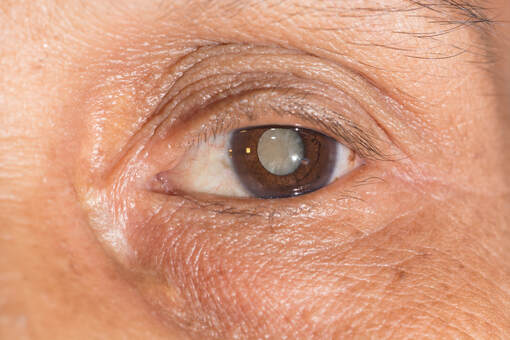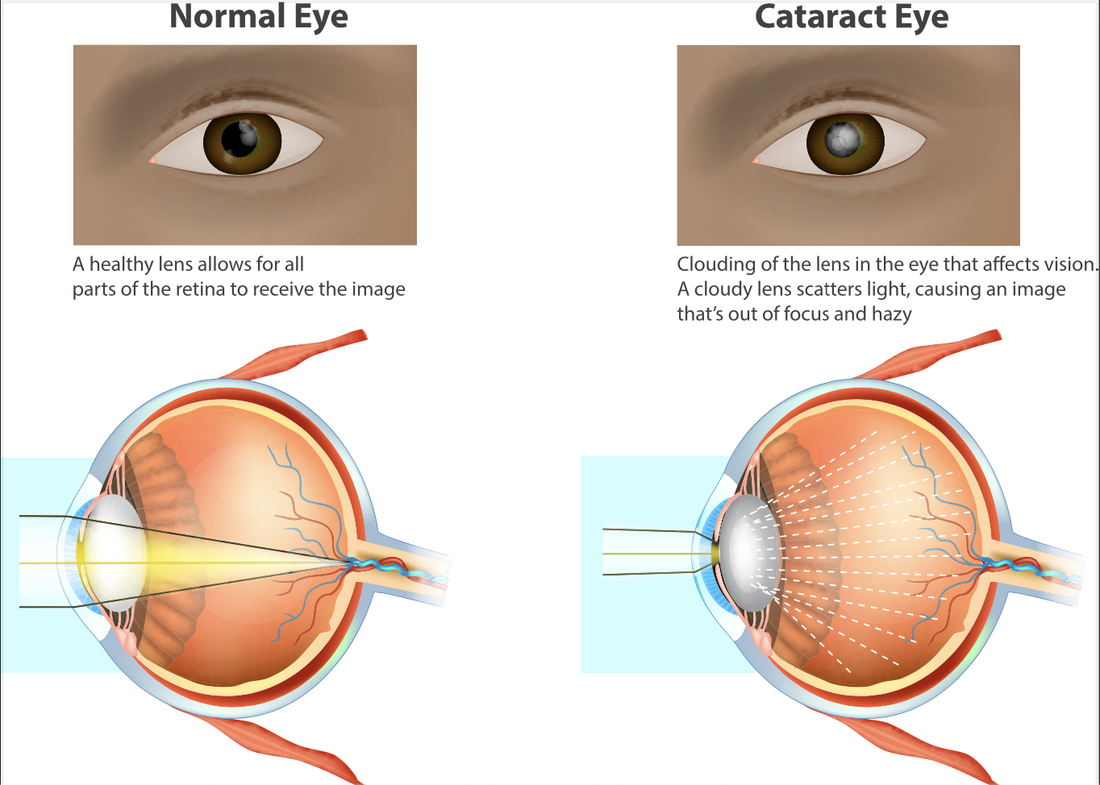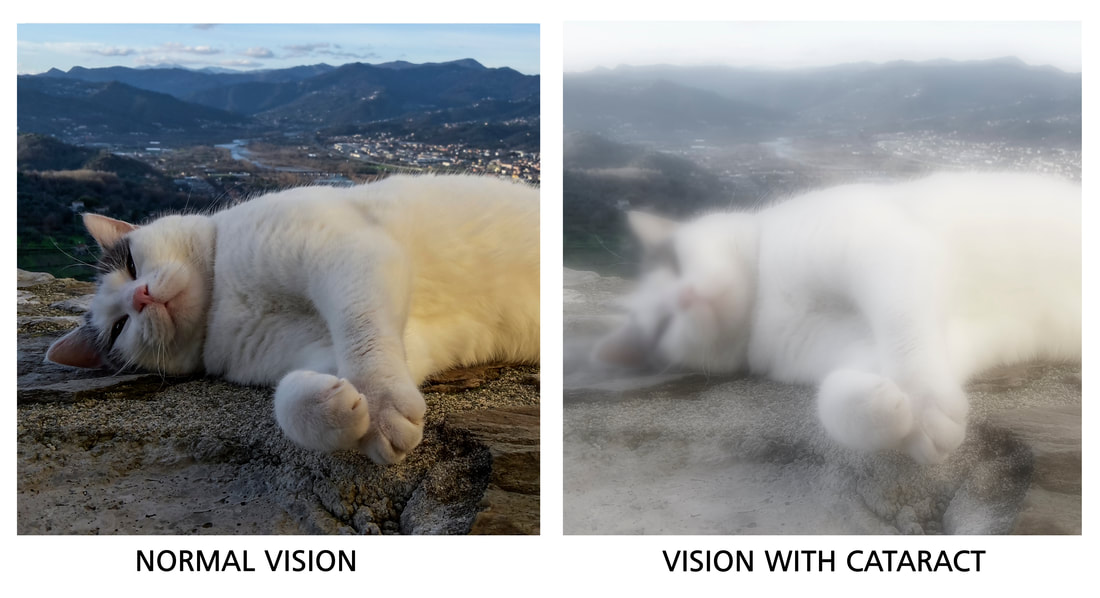What is a Cataract?
A cataract is a normal part of the aging process which begins as early as age 40. The natural lens in your eye should be clear, but when you have a cataract, it has become cloudy and is like looking through a foggy or dusty window. Things can look blurry, hazy, and less colorful with a cataract. A cataract can progress until your vision loss becomes significant enough to affect your daily activities such as driving, watching TV, or reading. Fortunately, cataract surgery can restore this lost vision.
What is involved in cataract surgery?
Because cataracts grow inside your natural lens, the only way to get rid of them is to remove the lens. Cataract surgery removes and replaces your natural lenses with an intraocular lens (IOL).
Before the procedure, your eye will be numbed with eye drops. You may also be given a medicine to help you relax. You will be awake during surgery, and you may see light and movement during the procedure, but you will not see what the doctor is doing to your eye.
The surgeon starts by creating a small incision in the cornea. This incision allows them to access the lens behind it. When they can reach the lens, the cataract is broken into tiny pieces, making it easier to remove. The pieces are removed with a light suction, the IOL is replaced, and the procedure is complete. The incision in the cornea heals on its own. There should be a dramatic improvement in vision within a few days. You will have to use eye drops for a few weeks after surgery and there will be some physical restrictions which we will go over with you. Be sure to follow these instructions
Traditional Cataract Surgery
Traditional cataract surgery is done manually by the surgeon without the use of a laser. A monofocal lens is implanted to improve your distance vision as much as possible. You will need glasses for reading after even if you didn’t before cataract surgery because you were near-sighted. You may also need glasses for distance, and will definitely need them if you have astigmatism, as traditional cataract surgery does not correct for that.
Laser-Assisted Cataract Surgery
Laser-assisted cataract surgery replaces the use of manual blades for cataract surgery, providing a gentle and specialized procedure just for your unique eyes. Before the surgery begins, the surgeon uses a laser to take pictures of the eye. These images go into a computer program, which creates a three-dimensional map of the eye. By personalizing your procedure with a 3-D blueprint of your eye, we account for every detail. The map then guides the surgeon through the procedure on the best location for the corneal incisions and helps in placing the IOL in the eye. The laser also breaks the lens into smaller pieces. In traditional cataract surgery, ultrasound frequencies break the lens. A laser reduces the damage and inflammation to the eye, which reduces the recovery time. Due to the precise nature of the laser, we can achieve better visual outcomes than in traditional cataract surgery. Laser Cataract Surgery can also correct smaller amounts of Astigmatism, giving the clearest possible distance vision.
Before the procedure, your eye will be numbed with eye drops. You may also be given a medicine to help you relax. You will be awake during surgery, and you may see light and movement during the procedure, but you will not see what the doctor is doing to your eye.
The surgeon starts by creating a small incision in the cornea. This incision allows them to access the lens behind it. When they can reach the lens, the cataract is broken into tiny pieces, making it easier to remove. The pieces are removed with a light suction, the IOL is replaced, and the procedure is complete. The incision in the cornea heals on its own. There should be a dramatic improvement in vision within a few days. You will have to use eye drops for a few weeks after surgery and there will be some physical restrictions which we will go over with you. Be sure to follow these instructions
Traditional Cataract Surgery
Traditional cataract surgery is done manually by the surgeon without the use of a laser. A monofocal lens is implanted to improve your distance vision as much as possible. You will need glasses for reading after even if you didn’t before cataract surgery because you were near-sighted. You may also need glasses for distance, and will definitely need them if you have astigmatism, as traditional cataract surgery does not correct for that.
Laser-Assisted Cataract Surgery
Laser-assisted cataract surgery replaces the use of manual blades for cataract surgery, providing a gentle and specialized procedure just for your unique eyes. Before the surgery begins, the surgeon uses a laser to take pictures of the eye. These images go into a computer program, which creates a three-dimensional map of the eye. By personalizing your procedure with a 3-D blueprint of your eye, we account for every detail. The map then guides the surgeon through the procedure on the best location for the corneal incisions and helps in placing the IOL in the eye. The laser also breaks the lens into smaller pieces. In traditional cataract surgery, ultrasound frequencies break the lens. A laser reduces the damage and inflammation to the eye, which reduces the recovery time. Due to the precise nature of the laser, we can achieve better visual outcomes than in traditional cataract surgery. Laser Cataract Surgery can also correct smaller amounts of Astigmatism, giving the clearest possible distance vision.
Watch the video below to learn how cataract surgery is performed
Complete Primary Eyecare
Hubbard Centre One
30 N Main Street Hubbard, OH 44425 |
Hours
Monday: 8:00 am - 4:30 pm Tuesday: 8:00 am - 4:30 pm Wednesday: 8:00 am - 4:30 pm Thursday: 8:00 am - 4:30 pm Friday: By appointment only Saturday: Closed Sunday: Closed |






